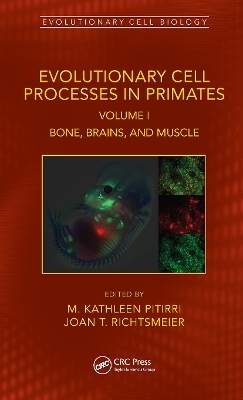
Evolutionary Cell Processes in Primates
CRC Press (Verlag)
978-1-032-07271-5 (ISBN)
Many complex traits define the human condition, including encephalization and bipedalism. The specific molecular signals and cellular processes producing these traits are the result of dramatic evolutionary change. At the same time, conservation of many of these developmental programs underlie both structure and function. Novel methodologies and techniques allow analysis of the collective behavior of cells, cell shapes, tissues, and organs. This volume demonstrates the essential role of cellular mechanisms in the evolutionary increase in the size and complexity of the primate brain. In addition, and concordant with encephalization, this book documents changes in the muscles and bones associated with the appearance of bipedalism. Genetic changes are the basis of these evolutionary changes, but transformation of genetic information into phenotypic outcomes occurs at the level of the cell, and this is the focus of the book. The goal is to encourage others to adopt evolutionary cell biology as a novel and necessary approach to the genotype-phenotype map of the diversification of primates, human variation, and human evolution. The contributors to this book utilize advances in genetic analysis, visualization of cells and tissues, and the merging of evolutionary developmental biology with evolutionary cell biology to address questions central to understanding the human and primate evolution.
Key Features
Explores mechanisms underlying trait distribution, dispersal, variation, and evolution through the direct testing of hypotheses especially with respect to patterns of encephalization, certain sensory modalities, and growth and life history specializations.
Documents the advantages for anthropologists to work at the level of cells focusing on how genes provide instructions for cells to make structure and how environmental influences affect the behavior of cells.
Illustrates the role cell biology plays with respect to encephalization, neocortical expansion, variation in facial morphology, locomotion, and dexterity.
Describes novel methodologies and techniques allowing analysis of how the collective behavior of cells shapes tissues and organs.
Related Titles
Ripamonti, U., ed. Induction of Bone Formation in Primates: The Transforming Growth Factor-beta 3 (ISBN 978-0-3673-7740-3).
Gordon, M. S., et al., eds. Animal Locomotion: Physical Principles and Adaptations (ISBN 978-0-3676-5795-6)
Bianchi, L. Developmental Neurobiology (ISBN 978-0-8153-4482-7)
Volume 1 Evolutionary Cell Processes in Primates: bone, brains, and muscle
Chapter 1 Introduction: Evolutionary cell biology in anthropological research
Joan T. Richtsmeier and M. Kathleen Pitirri
Chapter 2 The role of bone and cartilage cells in the evolution of bipedalism
Cambell Rolian
Chapter 3 Cellular processes in limb development and primate evolution
Philip L. Reno, Kelsey M. Kjosness, and Allison L. Machnicki
Chapter 4 A muscular perspective on human evolution: Locomotor insights from analyses of primate muscle architecture and fiber type
Andrew S. Deane, Jason M. Organ, and Magdalena N. Muchlinski
Chapter 5 Evolution of the encephalized human brain: How did we become exceptional?
Kevin Alloway and Kevin Flaherty
Chapter 6 Primate Cognition: cellular processes and the developmental mechanisms in brain expansion
Maria Carolina Marchetto and Katerina Semendeferi
Chapter 7 The role of primate embryogenesis in encephalization and neocortical expansion
Andrew Halley
Chapter 8 How gene expression can induce correlated changes in brain and skull systems
Neus Martínez-Abadías, Rubèn Gonzàlez, Roger Mateu, Jaume Sastre, Alexandre Robert-Moreno, Jim Swoger, Susan M. Motch Perrine, Kazuhiko Kawasaki, Joan Richtsmeier, and James Sharpe
Chapter 9 Cellular dynamics and the developmental basis for craniofacial variation in evolution and disease
Nathan M. Young, Ralph S. Marcucio, Benedikt Hallgrímsson, Heather A. Richbourg, and Rebecca M. Green
| Erscheinungsdatum | 06.09.2021 |
|---|---|
| Reihe/Serie | Evolutionary Cell Biology |
| Zusatzinfo | 7 Tables, black and white; 13 Line drawings, color; 12 Line drawings, black and white; 11 Halftones, color; 3 Halftones, black and white; 24 Illustrations, color; 15 Illustrations, black and white |
| Verlagsort | London |
| Sprache | englisch |
| Maße | 156 x 234 mm |
| Gewicht | 900 g |
| Themenwelt | Naturwissenschaften ► Biologie ► Zellbiologie |
| Naturwissenschaften ► Biologie ► Zoologie | |
| Weitere Fachgebiete ► Land- / Forstwirtschaft / Fischerei | |
| ISBN-10 | 1-032-07271-7 / 1032072717 |
| ISBN-13 | 978-1-032-07271-5 / 9781032072715 |
| Zustand | Neuware |
| Informationen gemäß Produktsicherheitsverordnung (GPSR) | |
| Haben Sie eine Frage zum Produkt? |
aus dem Bereich


